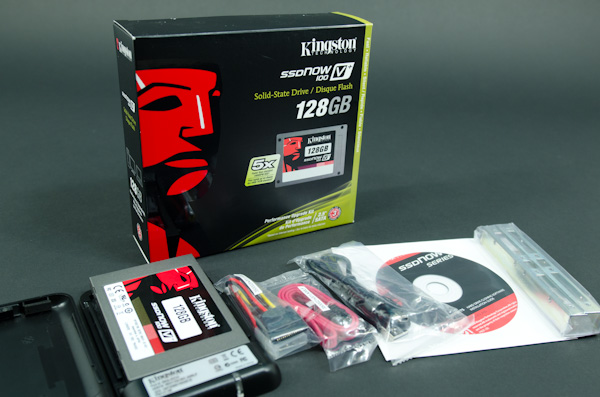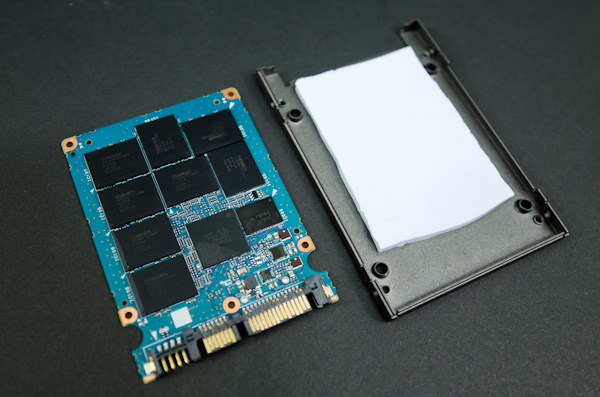Kingston SSDNow V+100 Review
by Anand Lal Shimpi on November 11, 2010 3:05 AM EST- Posted in
- Storage
- SSDs
- Kingston
- SSDNow V+100
Final Words
Kingston, like many of its competitors, desperately needs a simplified product lineup. On the one hand, Kingston has hedged its bets. With three different controller makers supplying hardware for its six SSDs, Kingston can't go wrong. However, the Toshiba powered SSDNow V+ spans the gamut from mediocre random write speed to chart topping performance in some of our workloads. The real world test results are strong enough for me to recommend the drive, however two things don't sit well with me.
First is the price. The V+100 commands a nearly $50 premium over competing SandForce drives. While I can understand paying some premium for Toshiba's name and hopefully reliability, that's a bit much. Compared to the RealSSD C300 the premium is negligible, so the complaint only applies as long as SandForce is in the running.

Kingston sells SSDs as both standalone drives or a part of an upgrade kit
The second issue is the overly aggressive garbage collection. Sequential performance on the V+100 just doesn't change regardless of how much fragmentation you throw at the drive. The drive is quick to clean and keeps performance high as long as it has the free space to do so. This is great for delivering consistent performance, however it doesn't come for free. I am curious to see how the aggressive garbage collection impacts drive lifespan. Kingston ships the V+100 with a 3-year warranty and to Kingston's credit I haven't had any other drives die as a result of wearing out the NAND. Even if the V+100 has higher effective write amplification than the competition, your usage model will determine whether or not you bump into it.
Toshiba is clearly close to knocking this one out of the park. There's a tangible improvement over the original V+ and the drive is clearly doing some things right. The V+100 isn't flawless, but it's finally in the list of drives to consider.
SandForce continues to be the sensible choice, at least in terms of performance per dollar for a boot/application drive. I am careful to mention it as a boot/application drive because if you start storing a lot of incompressible data on the drive (e.g. movies, music, photos) then SandForce quickly loses a lot of its performance advantage. Then you're left with Crucial's RealSSD C300 which delivers more consistent performance regardless of data, at the expense of lower steady state write performance. Without TRIM, the C300 can quickly get into a not-so-great performance situation.
If you don't want a SandForce drive and are running an OS without TRIM support, the V+100 is probably a better option than the C300 thanks to its aggressive garbage collection. I realize this isn't the simplest recommendation, but that's the reality of today's SSD market. There are a lot of great options, but nothing is absolutely perfect.











96 Comments
View All Comments
dagamer34 - Saturday, November 13, 2010 - link
If you're buying an SSD, I see no reason why your OS should still be Windows XP.Oxford Guy - Sunday, November 14, 2010 - link
Some may not want to pay the Microsoft tax.Out of Box Experience - Monday, November 15, 2010 - link
What you see is irrelevant to what I use!I see several good reasons to use XP and None to using Windows 7
The number 1 OS is still XP and has the highest user base so why does OCZ think the public will spend an extra $200 for Windows 7 just to use their overhyped SSD's?
Why doesn't OCZ just build SSD's for the majority of people on XP instead of making their customers jusmp though all these hoops just to get synthetic speeds from their drives that have little to do with real world results?
sprockkets - Sunday, November 21, 2010 - link
Oh, I don't know, TRIM support, built in alignment support, build in optimization after running WEI for SSDs?But if you want to stick with a 9 year old OS which lacks basic security, poor desktop video rendering, etc, go right on ahead.
Anand Lal Shimpi - Thursday, November 11, 2010 - link
Representing the true nature of "random" access on the desktop is very difficult to do. Most desktops don't exhibit truly random access, instead what you get is a small file write followed by a table update somewhere else in the LBA space (not sequential, but not random). String a lot of these operations together and you get small writes peppered all over specific areas of the drive. The way we simulate this is running a 100% random sweep of 4KB writes but constraining it to a space of about 8GB of LBAs. This is overkill as well for most users, however what the benchmark does do is give an indication of worst case small file, non-sequential write performance. I agree with you that we need more synthetic tests that are representative of exactly what desktop random write behavior happens to be, however I haven't been able to come across the right combination to deliver just that. Admittedly I've been off chasing phones and other SSD issues as of late (you'll read more about this in the coming weeks) so I haven't been actively looking for a better 4KB test.Now OS X feeling snappier vs. SandForce I can completely agree with. I don't believe this is 100% attributable to the data you see here, Apple also has the ability to go in and tweak its firmwares specifically for its software. I believe the ultra quick response time you see from boot and resume comes from firmware optimizations specific to OS X. Although I am going to toss this Kingston drive in my MBP to see what things look like at that point.
Take care,
Anand
iwodo - Friday, November 12, 2010 - link
ARH, Thx,"toss this Kingston drive in my MBP to see what things look like at that point."
I never thought of that. Keep thinking mSATA was blocking anyone from testing it.
I am looking forward to see your SSD issues and MBP testing.
Tech news has been dull for number of years, SSD finally make thing interesting again.
sunjava04 - Friday, November 12, 2010 - link
hey anand,would you provide a different SSD test result with macbook pro?
like me, many macbook unibody or new mac book pro users use mainly for browsers and office, iphoto, itunes. we like to have ssd to make our experience better and faster. i search many website and blogs, but there are no clear answer for this.
even, apple keeping quite about "TRIM" support!
after, reading your article, i am still not sure which ssd is good for my macbook unibody. i got the an idea of garbage collection which was very helpful. but didn't know, how long ssd last if we use for general purpose?
i really appreciate if you provide descriptive guideline of ssd for OS X.
please, also tell us, is it worth to waiting for intel 3rd gen.?
i desperately need ssd for mac book unibody!
i dont mind to pay premium as long as performance stay as it is! also, i can store movies and other data in external hard drive!
Sincerely,
Rishi
iwodo - Saturday, November 13, 2010 - link
As of Today, i just read another review on SSD comparison. Namely Intel SSD and Sandforce,While the Sandforce wins on all synthetic benchmarks like Seq Read Write and Random Read Write.
It was booting slower, starting up Apps slower, finish task slower then Intel SSD.
And by an noticeable amount of percentage. ( 10 - 30% )
I am beginning to think there are things Sandforce dont work well at all. But again, we have yet to find out what.
Out of Box Experience - Tuesday, November 16, 2010 - link
Sandforce controllers give you the "illusion" of speed by writing less data to flash than contollers without hardware compressionIf I wanted to test the speed of a copy and paste involving 200MB of data in the flash cells of a sandforce based controller, how can I tell exactly how much data is in the flash cells?
I mean, would Windows tell me how much compressed data is represented in the flash cells (200MB), or would Windows tell me how much compressed data is in the cells (maybe only 150MB) ?
The only way I can see fairly comparing an SSD with hardware compression and one without is to be sure you are actually writing the same amount of data to the flash cells (in this case - 200MB)
If sandforce based SSD's will only tell you how much data is represented and not what is actually on the drive, then I think the best way would be to use data that cannot be compressed
The tests I described in another post here involved copying and pasting 200MB of data which took 55 seconds on an ATOM computer with a Vertex 2
200MB / 55 sec = 3.6MB/sec
But if the 200MB was only a representation and the actual amount of data was for example 165MB in flash, then the actual throughput of my Vertex was even worse than I thought (In this case - 165MB / 55sec = 3.0MB/sec)
I need to know exactly how much data is indeed in flash or I need to start using non-compressible data for my tests
Make sense?
Out of Box Experience - Monday, November 15, 2010 - link
There has to be an missing pieces in our performance test, something that these companies knows and we dont.------------------------------------------
Like smoke & Mirrors?
Sandforce Controllers Compress the data to give you the impression of speed
check the speed without compression and then compare drives